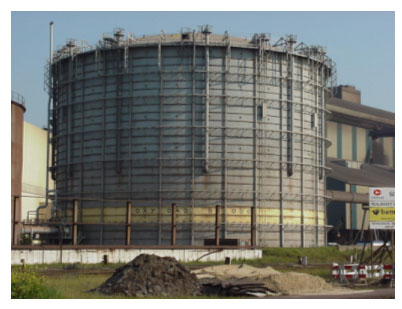-
What are the applications of Basic Oxygen Furnace Gas (BOFG)?
Date posted:
-
-
Post Author
dev@edge.studio
1. Introduction
The typical fuel gases used in integrated iron and steelworks are listed in CF62 and introduced in more detail in CF100. This group of industrial fuel gases includes the byproduct of [GLOSS]Basic Oxygen Steelmaking[/GLOSS] ([GLOSS]BOS[/GLOSS]), referred to here as [GLOSS]Basic Oxygen Furnace Gas[/GLOSS] or [GLOSS]BOFG[/GLOSS], but also known as [GLOSS]Basic Oxygen Steelmaking Gas[/GLOSS].
BOFG is produced as a by-product of the process of decarburising liquid iron ([GLOSS]hot metal[/GLOSS]) in a [GLOSS]Basic Oxygen Furnace[/GLOSS], [GLOSS]BOF[/GLOSS]. Decarburised liquid iron is called liquid steel.
BOFG is a low to medium [GLOSS]calorific value[/GLOSS] fuel gas, which can be used as gaseous fuel in various applications inside and outside the steel plant.
The production of BOFG, and the fuel properties of BOFG with its combustion and [GLOSS]flue gas[/GLOSS] properties, are described in associated Combustion File numbers 219, and 245 respectively. The present CF concentrates on basic oxygen furnace gas utilisation.
2. Storage and Distribution
Cleaned Basic Oxygen Furnace Gas is ready to be used as fuel in several applications. Therefore it must be stored and distributed. This is normally done by gasholders and pipelines. In Figure 1 the Basic Oxygen Furnace Gas holder of Corus IJmuiden is shown.
The IJmuiden gasholder may contain up to 80,000 cubic meters of gas at a pressure up to 15 mbar. The gasholder acts to smooth out short-term differences between the rate of supply from the steel plant and the rate of use, and gas composition differences in time are smoothed out. It also helps by providing a constant supply pressure for Basic Oxygen Steelmaking Gas compressors. The gas compressors elevate the pressure of the Basic Oxygen Steelmaking Gas up to 300 to 500 mbar for distribution via the pipelines.

Figure 1. Basic Oxygen Furnace Gas Holder of Corus IJmuiden
3. Applications
BOFG is well suited to be used in furnaces and power plant (boilers and gas turbines). To transport the BOFG from the gasholder to the consumers, a distribution net via pipelines is necessary. Since BOFG is normally saturated with water vapour, drip legs need to be installed in the piping system to remove water. This, together with the required maintenance of the fuel lines (i.e. regular inspection, mechanical and chemical cleaning), makes the fuel lines very expensive.
As described above, BOFG may be used as a pure fuel but it is also very suitable as so-called “make-up” fuel. In that case BOFG is mixed with another gas (e.g. Blast Furnace Gas) to enhance and control the calorific value (or [GLOSS]Wobbe Index/Number[/GLOSS]) of the gas mixture.
4. Health and safety considerations
Basic Oxygen Steelmaking Gas is a highly toxic gas since it contains significant amounts of carbon monoxide. It is a highly explosive gas. Inhaling large amounts of Basic Oxygen Steelmaking Gas directly causes dizziness followed by falling into a faint and eventually causes death. Long term inhaling of small amounts of this gas might lead to cancer and is detrimental for the unborn child [6].
Sources
[1] American Iron and Steel Institute, www.steel.org.
[2] Stubbles, J., The basic oxygen steelmaking BOS process, www.steel.org.
[3] AISE Steel Foundation, 1998, Making, Shaping, and Treating of Steel, 11th Edition, Steelmaking And Refining Volume. Pittsburgh PA
[4] Zabetakis, M.G., Flammability characteristics of combustible gases and vapors, Bulletin 627, Bureau of Mines, 1965.
[5] N.V. Nederlandse Gasunie, Physical properties of natural gases, Groningen, Netherlands, 1980.
[6] Informatie Chemische Stoffen, werkinstructiekaart oxygas, Corus, 2002.
